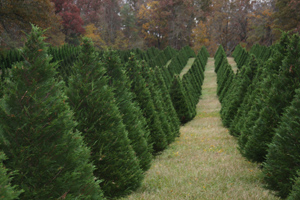Many Georgians remember hiking into nearby woods as children to chop down that most iconic of all holiday decorations: the family Christmas tree. These days, a suitable one is less likely found in the backyard. But the experience can still be found, along with that perfect tree, among the acreage at a choose-and-cut tree farm.
“It’s all about the experience,” said Liza Smith, owner of 7 G’s Farm in Nicholson, Ga. “Families come out here and find their perfect Christmas tree together. It is really amazing to watch the excitement in children.”
Given a saw and direction, shoppers navigate the farm. Along with spotting deer frolicking among the trees or enjoying a chance encounter with Santa, visitors take home more than just a tree.
“We describe it as an oxygen-enriched atmosphere,” said Greg Smith, the farm’s manager. “One acre of Christmas trees provides enough oxygen for 18 people.”
With over 6,000 trees, the air at 7 G’s Farm is rich. The farm sells Leyland Cypress ranging from 5 feet to 13 feet tall for $6 a foot. Last year, they sold 1,000 trees.
“Our business is growing every year,” Smith said. “But, we saw people opting for smaller, more modest trees last year, probably in response to the economy.”
Christmas tree farming in Georgia brought more than $8.5 million to the state’s economy last year, according to the annual Georgia Farm Gate Value Report from the University of Georgia Center for Agribusiness and Economic Development.
Most Georgia tree farms offer Cypress varieties, but some offer Virginia Pine, White Pine or Redcedar trees, too.
Choose-and-cut farms are the perfect place to purchase the freshest tree possible.
“Fresh trees can last from the first of November through Christmas, if you keep it supplied with water,” said David Moorhead, an extension specialist with the UGA Warnell School of Forestry and Natural Resources.
A six-foot tree can take up to a gallon of water a day, Moorhead said.
“Fill the tree stand when you bring it in and check it twice a day,” he said. “If you let the tree dry out, the base will seal up and it will be difficult to get any water into the tree.”
Dry trees can be a fire hazard. Keeping an adequate water supply flowing to the tree is paramount. Keep trees away from heat sources such as vents or fireplaces to help prevent drying.
Trees cut and shipped to retail outlets for the holiday season are typically grown in states further north or west of Georgia. Many spend weeks without water. To test for freshness, shake the tree vigorously before buying it. If a shower of needles falls, move on.
“If it looks wilted, select a fresher tree,” Moorhead said. “If it doesn’t look good when you buy it, it won’t resurrect itself at your house.”
Regardless of where you buy your Christmas tree, cut half an inch off the bottom before placing it into a tree stand. Giving the tree a fresh cut will help it take up as much water as it can and stay fresher longer.
Keep your ceiling height in mind when selecting a tree. Be sure to get a tree that will fit in your house. If you have an eight-foot ceiling, a seven-foot tree is about as large as you can fit.
“There is nothing worse than getting a perfect tree home and realizing it won’t fit,” Moorhead said. “Hacking off the bottom of the tree to make it fit is not a good idea.”
For a list of Georgia’s choose and cut Christmas tree farms visit www.gacta.com/pdf/choose_cut_big.php.






.jpg)

